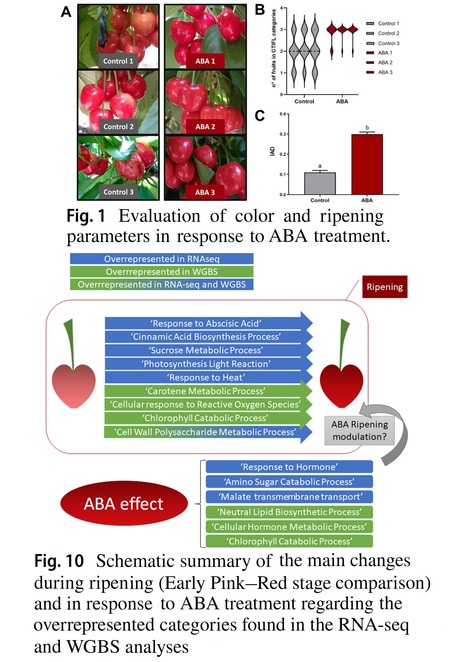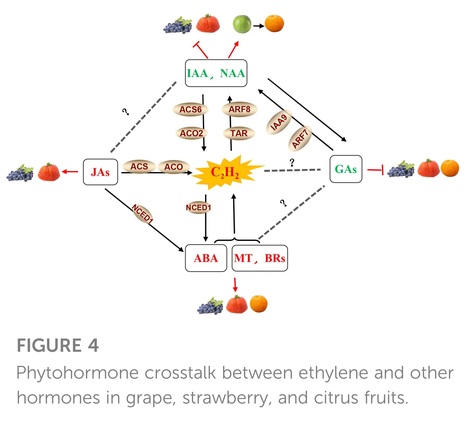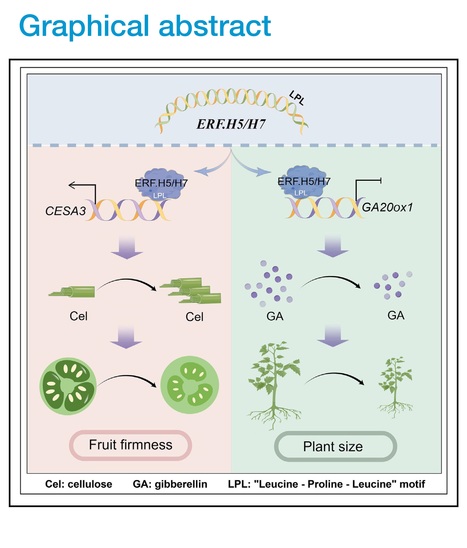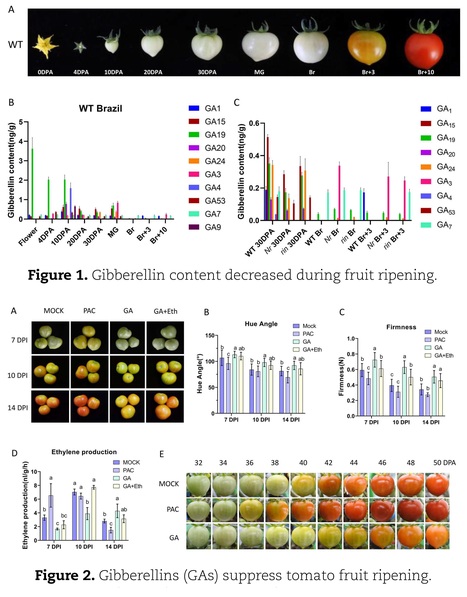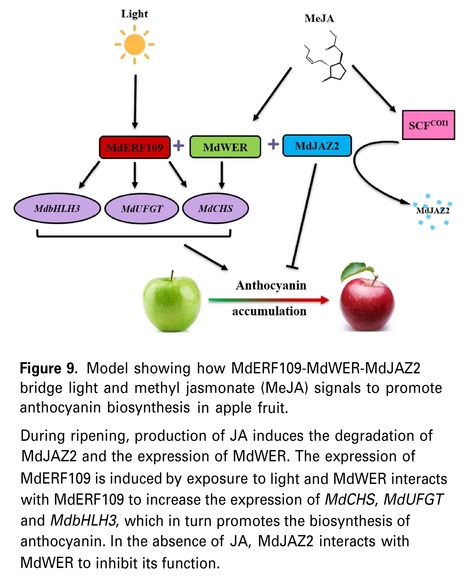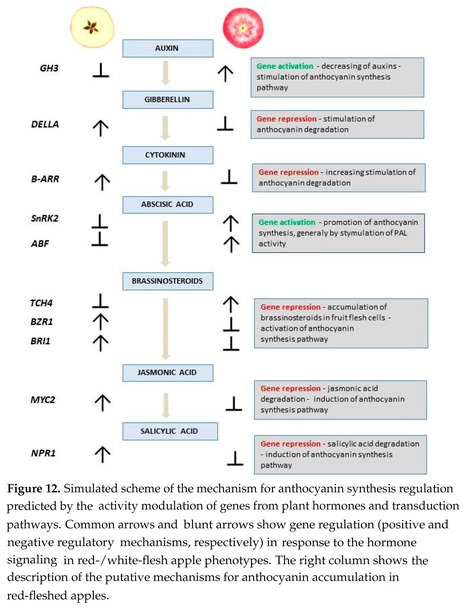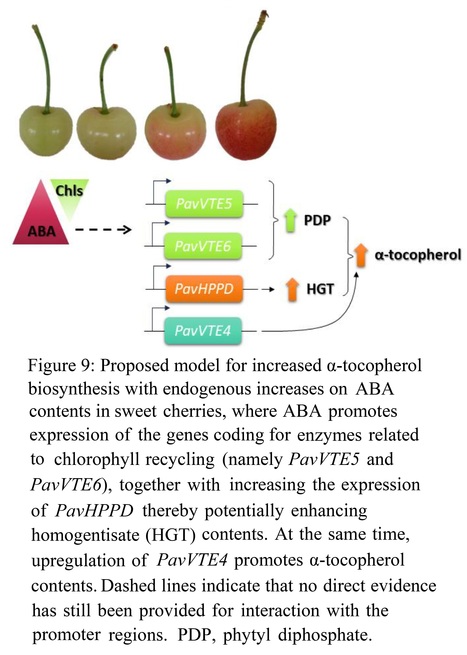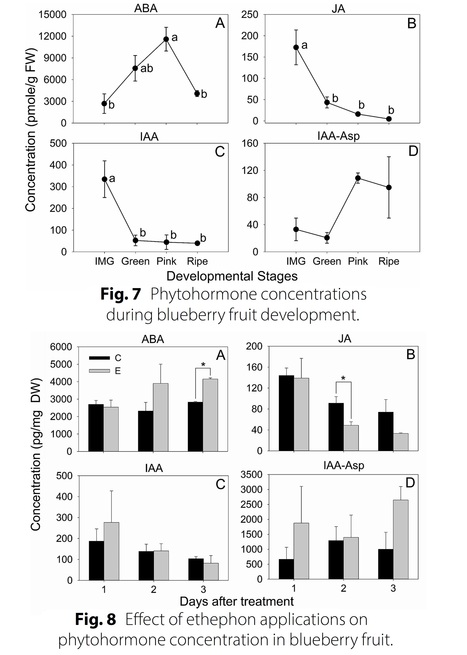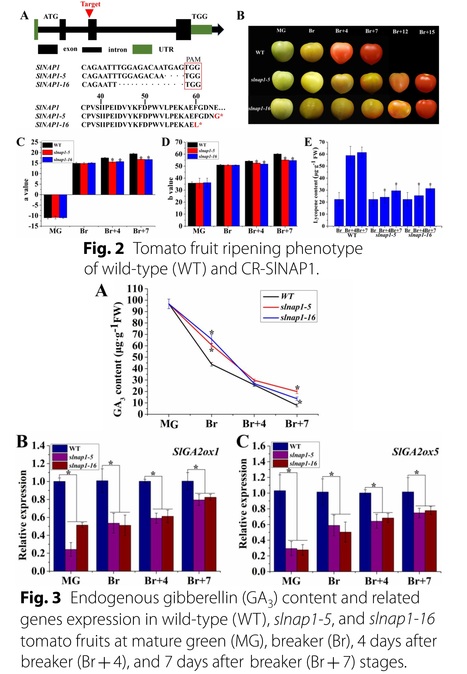 Your new post is loading...
 Your new post is loading...
Authors: Xuexue Chen, Jiahui Gao and Yuanyue Shen.
The Plant Journal (2024)
Significance Statement: We unravel a novel abscisic acid signaling transduction pathway in sugar transport via “FaRIPK1-FaTCP7-FaSTP13/FaSPT,” which channels to strawberry fruit ripening.
Abstract: "Strawberry is considered as a model plant for studying the ripening of abscisic acid (ABA)-regulated non-climacteric fruits, a process in which sugar plays a fundamental role, while how ABA regulates sugar accumulation remains unclear. This study provides a direct line of physiological, biochemical, and molecular evidence that ABA signaling regulates sugar accumulation via the FaRIPK1-FaTCP7-FaSTP13/FaSPT signaling pathway. Herein, FaRIPK1, a red-initial protein kinase 1 previously identified in strawberry fruit, not only interacted with the transcription factor FaTCP7 (TEOSINTE BRANCHEN 1, CYCLOIDEA, and PCF) but also phosphorylated the critical Ser89 and Thr93 sites of FaTCP7, which negatively regulated strawberry fruit ripening, as evidenced by the transient overexpression (OE) and virus-induced gene silencing transgenic system. Furthermore, the DAP-seq experiments revealed that FvTCP7 bound the motif “GTGG CCCNC” in the promoters of two sugar transporter genes, FaSTP13 (sugar transport protein 13) and FaSPT (sugar phosphate/phosphate translocator), inhibiting their transcription activities as determined by the electrophoretic mobility shift assay, yeast one-hybrid, and dual-luciferase reporter assays. The downregulated FaSTP13 and FaSPT transcripts in the FaTCP7-OE fruit resulted in a reduction in soluble sugar content. Consistently, the yeast absorption test revealed that the two transporters had hexose transport activity. Especially, the phosphorylation-inhibited binding of FaTCP7 to the promoters of FaSTP13 and FaSPT could result in the release of their transcriptional activities. In addition, the phosphomimetic form FaTCP7S89D or FaTCP7T93D could rescue the phenotype of FaTCP7-OE fruits. Importantly, exogenous ABA treatment enhanced the FaRIPK1–FaTCP7 interaction. Overall, we found direct evidence that ABA signaling controls sugar accumulation during strawberry fruit ripening via the “FaRIPK1-FaTCP7-FaSTP13/FaSPT” module."
Authors: Nathalie Kuhn, Macarena Arellano, Claudio Ponce, Christian Hodar, Francisco Correa, Salvatore Multari, Stefan Martens, Esther Carrera, José Manuel Donoso and Lee A. Meisel
Journal of Plant Growth Regulation (2024)
Abstract: "Abscisic acid (ABA) is a plant hormone that plays a key role in the ripening process of non-climacteric fruits, triggering pigment production, fruit softening, and sugar accumulation. Transcriptional studies show that ABA modifies the expression of several ripening-related genes, but epigenetic effects of ABA during this process are lacking. Therefore, this work aimed to perform transcriptomic and DNA methylation analyses of fruit samples treated with ABA during the fruit ripening process in the non-climacteric sweet cherry model. RNA-seq analyses revealed an overrepresentation of transcripts annotated in functional categories related to ABA response, secondary metabolism, and sugar synthesis during fruit ripening. In contrast, Whole Genome Bisulfite Sequencing (WGBS) analyses revealed DNA hypomethylation in the 5′UTR region of genes related to carotene catabolism. Transcriptional and epigenetic regulation of genes encoding xyloglucan enzymes, associated with cell wall modifications, were also detected. ABA treatment enhanced fruit color development and the accumulation of ripening markers, including carotenoids and several anthocyanins. Gene Ontology analysis in the RNA-seq of ABA-treated fruits revealed expression variations in genes encoding members of the Aux/IAA and ARF families. In the WGBS analysis, genes encoding enzymes for cytokinin biosynthesis had differential DNA methylation after the ABA treatment. Our work identified ABA-modulated factors at the genetic and epigenetic levels, suggesting complex hormone networks controlling non-climacteric sweet cherry fruit ripening."
Authors: Meiying Liu, Chaoran Wang, Hongliang Ji, Maoxiang Sun, Tongyu Liu, Jiahao Wang, Hui Cao and Qinggang Zhu.
Frontiers in Plant Science (2024)
Abstract: "In recent years, the ethylene-mediated ripening and softening of non-climacteric fruits have been widely mentioned. In this paper, recent research into the ethylene-mediated ripening and softening of non-climacteric fruits is summarized, including the involvement of ethylene biosynthesis and signal transduction. In addition, detailed studies on how ethylene interacts with other hormones to regulate the ripening and softening of non-climacteric fruits are also reviewed. These findings reveal that many regulators of ethylene biosynthesis and signal transduction are linked with the ripening and softening of non-climacteric fruits. Meanwhile, the perspectives of future research on the regulation of ethylene in non-climacteric fruit are also proposed. The overview of the progress of ethylene on the ripening and softening of non-climacteric fruit will aid in the identification and characterization of key genes associated with ethylene perception and signal transduction during non-climacteric fruit ripening and softening."
Authors: Xianghan Cheng, Feifei Liu, Xiaolei Liu and Xuan Yang.
Journal of the Science of Food and Agriculture (2024)
Abstract: "Background - The influences of abscisic acid (ABA) applications on precursors and gene expression in 3-alkyl-2-methoxypyrazines (MPs) biosynthetic pathway, MPs concentration and sensory evaluation of its derived peculiar odors in Cabernet Sauvignon grapes and wines were investigated. At the vineyard, ABA solution with 25, 100 and 400 mg L−1 (AT1, AT2 and AT3, respectively) and an aqueous solution (control) were sprayed three times from veraison to pre-harvest. Results - Higher concentration ABA applications (AT2 and AT3) in grapes could significantly reduce MPs concentration and its derived peculiar odors in grapes and wines compared to a lower concentration ABA application (AT1) and control, with AT2 application having the strongest effect. The changes in MPs were mainly a result of the downregulated expression of VvOMTs genes at higher concentration ABA applications, independent of the levels of their potential precursors. Conclusion - The present study reveals that ABA application had the potential to decrease production of MPs in Cabernet Sauvignon grapes and wines, and this result provides reference values for the removal of unpleasant vegetable odors from Cabernet Sauvignon wines in production.
Author: Daniel J. Cosgrove.
Annual Review of Plant Cell and Development (2024)
Abstract: "Expansins comprise an ancient group of cell wall proteins ubiquitous in land plants and their algal ancestors. During cell growth, they facilitate passive yielding of the wall's cellulose networks to turgor-generated tensile stresses, without evidence of enzymatic activity. Expansins are also implicated in fruit softening and other developmental processes and in adaptive responses to environmental stresses and pathogens. The major expansin families in plants include α-expansins (EXPAs), which act on cellulose-cellulose junctions, and β-expansins, which can act on xylans. EXPAs mediate acid growth, which contributes to wall enlargement by auxin and other growth agents. The genomes of diverse microbes, including many plant pathogens, also encode expansins designated expansin-like X. Expansins are proposed to disrupt noncovalent bonding between laterally aligned polysaccharides (notably cellulose), facilitating wall loosening for a variety of biological roles."
Authors: Dongmei Yan and Huilan Yi.
Scientia Horticulturae (2024)
Highlights • Identifying key genes and pathways for postharvest preservation of grapes by RNA-seq. • SO2 prolongs the postharvest shelf life of table grapes by reducing cell wall degradation and enhancing defenses of the skins. • SO2-triggered secondary metabolism and defense responses in grape fruits contributed to postharvest preservation. • SO2-induced inhibition of ethylene signaling pathway helped to delay postharvest softening and aging of grape fruits.
Abstract: "Sulfur dioxide (SO2) is the most frequently used preservative for table grapes, yet the preservation mechanism remains unclear. To ascertain the specific genes and pathways involved in SO2 preservation, RNA-seq technology was employed to characterize the transcriptome profile of grapes during postharvest storage. A total of 22,288 genes were identified, of which 377 genes were differentially expressed (≥ 2-fold change) between SO2 and control groups, mainly enriched in secondary metabolism, plant-pathogen interactions, plant hormone signaling, etc. Numerous genes encoding pathogenesis-related (PR) proteins exhibited higher expression levels in SO2 group, while the activities of disease-resistant enzymes, such as β-1,3-glucanase (PR2) and chitinase (PR3) significantly increased by 28.9 % and 29.3 % (P < 0.05), indicating SO2-induced plant resistance. Exposure to SO2 also enhanced the expression of genes encoding essential enzymes of secondary metabolism, and significantly increased both the activities of critical enzymes for the biosynthesis of secondary metabolites, such as phenylalanine ammonia-lyase (PAL) and 4-coumarate-CoA ligase (4CL), and the contents of secondary metabolites such as total phenol, flavonoid, anthocyanin, and lignin, demonstrating an enhanced chemical and physical barriers in SO2-fumigated grapes. Meanwhile, the genes associated with ethylene signaling and cell wall degradation were down-regulated by SO2 preservative, and some ethylene-responsive elements were identified in the promoter regions of cell wall hydrolase genes, suggesting that SO2-inhibited ethylene signaling might contribute to maintaining cell wall integrity. Altogether, gene expression patterns and cellular physiological processes were altered in grapes exposed to SO2, which helped maintain fruit quality and prolong postharvest life by regulating the defense responses and fruit ageing."
Authors: Lijuan Zhu, Haitao Yu, Xiaoyu Xu and Zhifang Yu.
Postharvest Biology and Technology (2024)
Highlights: • 10 μM MeJA inhibited ethylene biosynthesis and maintained better fruit quality in peach. • JA-biosynthetic pathway enhanced by MeJA was repressed during storage. • MeJA activated the negative feedback of JA-signaling pathway in peach.
Abstract: "Peach undergoes a rapid ripening and senescence, resulting in quality deterioration after harvest. Ethylene is essential for ripening and senescence in climacteric fruit. Although methyl jasmonate (MeJA) has been found to suppress ethylene biosynthesis, the underlying mechanism is unknown. We investigated the regulation of MeJA treatment (10 μM, 24 h) on the quality, ethylene biosynthesis and signaling, and jasmonic acid (JA) metabolism and signaling in ‘Xiahui 8’ peach stored at 20 °C. MeJA treatment maintained better fruit quality and reduced ethylene production (the reduction of peak value reached 24 %) during storage. The activities of 1-aminocyclopropane-1-carboxylate synthase (ACS) and 1-aminocyclopropane-1-carboxylate oxidase (ACO) decreased by 15–28 % and 15–19 % in MeJA treated fruit during storage. Additionally, the expressions of genes involved in ethylene signaling were downregulated in MeJA treated fruit. MeJA treatment enhanced JA biosynthesis through increasing the activities of allene oxide synthase (AOS), allene oxide cyclase (AOC) and JA-amino synthetase (JAR) during early storage. However, the JA-inducible catabolic pathways and self-repression of myelocytomatosis proteins2 (MYC2) were activated in MeJA treated fruit thereafter. This resulted in the decrease of PpMYC2 transcription and JA-Ile accumulation, which reduced by at most 56 % and 73 % when compared with CK, respectively, on day 0 and day 5. These results suggested that negative feedback regulation terminated and repressed the JA signaling, therefore diminishing its enhancement effect on ethylene biosynthesis in peach during storage."
Authors: Yangang Pei, Qihan Xue, Peng Shu, Weijie Xu, Xiaofei Du, Mengbo Wu, Kaidong Liu, Julien Pirrello, Mondher Bouzayen, Yiguo Hong and Mingchun Liu.
Developmental Cell (2024)
Editor's view: Pei et al. demonstrate the role of bifunctional transcription factors SlERF.H5 and SlERF.H7 in activating the cellulose biosynthesis gene SlCESA3 while repressing the gibberellin biosynthesis gene GA20ox1. The study highlights the distinct transcriptional regulatory functions of these ERFs in promoting cell wall formation and inhibiting plant growth.
Highlights • Cellulose is required for cell wall formation and firmness maintenance of fruits • SlERF.H5 and SlERF.H7 act as both transcriptional activators and repressors • The regulatory activity of SlERF.H5 and SlERF.H7 is mediated by a conserved motif
Abstract: "The plant cell wall is a dynamic structure that plays an essential role in development, but the mechanism regulating cell wall formation remains poorly understood. We demonstrate that two transcription factors, SlERF.H5 and SlERF.H7, control cell wall formation and tomato fruit firmness in an additive manner. Knockout of SlERF.H5, SlERF.H7, or both genes decreased cell wall thickness, firmness, and cellulose contents in fruits during early development, especially in double-knockout lines. Overexpressing either gene resulted in thicker cell walls and greater fruit firmness with elevated cellulose levels in fruits but severely dwarf plants with lower gibberellin contents. We further identified that SlERF.H5 and SlERF.H7 activate the cellulose biosynthesis gene SlCESA3 but repress the gibberellin biosynthesis gene GA20ox1. Moreover, we identified a conserved LPL motif in these ERFs responsible for their activities as transcriptional activators and repressors, providing insight into how bifunctional transcription factors modulate distinct developmental processes."
Authors: Heng Deng, Yangang Pei, Xin Xu, Xiaofei Du, Qihan Xue, Zhuo Gao, Peng Shu, Yi Wu, Zhaoqiao Liu, Yongfei Jian, Mengbo Wu, Yikui Wang, Zhengguo Li, Julien Pirrello, Mondher Bouzayen, Wei Deng, Yiguo Hong and Mingchun Liu.
New Phytologist (2024)
Abstract: The plant hormone ethylene plays a critical role in fruit defense against Botrytis cinerea attack, but the underlying mechanisms remain poorly understood. Here, we showed that ethylene response factor SlERF.C1 acts as a key regulator to trigger the ethylene-mediated defense against B. cinerea in tomato fruits without compromising ripening. Knockout of SlERF.C1 increased fruit susceptibility to B. cinerea with no effect on ripening process, while overexpression enhanced resistance. RNA-Seq, transactivation assays, EMSA and ChIP-qPCR results indicated that SlERF.C1 activated the transcription of PR genes by binding to their promoters. Moreover, SlERF.C1 interacted with the mitogen-activated protein kinase SlMPK8 which allowed SlMPK8 to phosphorylate SlERF.C1 at the Ser174 residue and increases its transcriptional activity. Knocking out of SlMPK8 increased fruit susceptibility to B. cinerea, whereas overexpression enhanced resistance without affecting ripening. Furthermore, genetic crosses between SlMPK8-KO and SlERF.C1-OE lines reduced the resistance to B. cinerea attack in SlERF.C1-OE fruits. In addition, B. cinerea infection induced ethylene production which in turn triggered SlMPK8 transcription and enhanced the phosphorylation of SlERF.C1. Overall, our findings reveal the regulatory mechanism of the ‘Ethylene-MPK8-ERF.C1-PR’ module in resistance against B. cinerea and provide new insight into the manipulation of gray mold disease in fruits."
Authors: Mengbo Wu, Kaidong Liu, Honghai Li, Ying Li, Yunqi Zhu, Dan Su, Yaoxin Zhang, Heng Deng, Yikui Wang and Mingchun Liu.
Horticulture Research (2024)
Abstract: "The phytohormone ethylene is well known for its important role in the ripening of climacteric fruit, such as tomato (Solanum lycopersicum). However, the role and mode of action of other plant hormones in climacteric fruit ripening regulation are not fully understood. Here, we showed that exogenous GA treatment or increasing endogenous gibberellin content by overexpressing the gibberellin synthesis gene SlGA3ox2 specifically in fruit tissues delayed tomato fruit ripening, whereas treatment with the GA biosynthesis inhibitor paclobutrazol (PAC) accelerated fruit ripening. Moreover, exogenous ethylene treatment cannot completely reverse the delayed fruit ripening phenotype. Furthermore, exogenous GA treatment of ethylene signalling mutant Never ripe (Nr) or SlEBF3-overexpressing lines still delayed fruit ripening, suggesting that GA involved in fruit ripening partially depends on ethylene. Transcriptome profiling showed that gibberellin affect the ripening of fruits by modulating the metabolism and signal transduction of multiple plant hormones, such as auxin and abscisic acid, in addition to ethylene. Overall, the results of this study provide new insight into the regulation of gibberellin in fruit ripening through mediating multiple hormone signals."
Authors: Xi Zhang, Lujia Yu, Mengjiao Zhang, Ting Wu, Tingting Song, Yuncong Yao, Jie Zhang and Ji Tian.
The Plant Journal (2024)
Significance Statement: Our findings validate a role for the MdERF109-MdWER-MdJAZ2 module in anthocyanin biosynthesis and uncover a novel mechanism for how light and MeJA signals are coordinated anthocyanin biosynthesis in apple fruit.
Abstract: "Anthocyanin generation in apples (Malus domestica) and the pigmentation that results from it may be caused by irradiation and through administration of methyl jasmonate (MeJA). However, their regulatory interrelationships associated with fruit coloration are not well defined. To determine whether MdERF109, a transcription factor (TF) involved in light-mediated coloration and anthocyanin biosynthesis, has synergistic effects with other proteins, we performed a yeast two-hybrid assessment and identified another TF, MdWER. MdWER was induced by MeJA treatment, and although overexpression of MdWER alone did not promote anthocyanin accumulation co-overexpression with MdERF109 resulted in significantly increase in anthocyanin biosynthesis. MdWER may form a protein complex with MdERF109 to promote anthocyanin accumulation by enhancing combinations between the proteins and their corresponding genes. In addition, MdWER, as a MeJA responsive protein, interacts with the anthocyanin repressor MdJAZ2. Transient co-expression in apple fruit and protein interaction assays allowed us to conclude that MdERF109 and MdJAZ2 interact with MdWER and take part in the production of anthocyanins upon MeJA treatment and irradiation. Our findings validate a role for the MdERF109-MdWER-MdJAZ2 module in anthocyanin biosynthesis and uncover a novel mechanism for how light and MeJA signals are coordinated anthocyanin biosynthesis in apple fruit."
Authors: Sylwia Keller-Przybylkowicz, Michal Oskiera , Xueqing Liu, Laiqing Song, Lingling Zhao, Xiaoyun Du, Dorota Kruczynska, Agnieszka Walencik, Norbert Kowara and Grzegorz Bartoszewski.
International Journal of Molecular Sciences (2024)
Abstract: "The red flesh coloration of apples is a result of a biochemical pathway involved in the biosynthesis of anthocyanins and anthocyanidins. Based on apple genome analysis, a high number of regulatory genes, mainly transcription factors such as MYB, which are components of regulatory complex MYB-bHLH-WD40, and several structural genes (PAL, 4CL, CHS, CHI, F3H, DFR, ANS, UFGT) involved in anthocyanin biosynthesis, have been identified. In this study, we investigated novel genes related to the red-flesh apple phenotype. These genes could be deemed molecular markers for the early selection of new apple cultivars. Based on a comparative transcriptome analysis of apples with different fruit-flesh coloration, we successfully identified and characterized ten potential genes from the plant hormone transduction pathway of auxin (GH3); cytokinins (B-ARR); gibberellins (DELLA); abscisic acid (SnRK2 and ABF); brassinosteroids (BRI1, BZR1 and TCH4); jasmonic acid (MYC2); and salicylic acid (NPR1). An analysis of expression profiles was performed in immature and ripe fruits of red-fleshed cultivars. We have uncovered genes mediating the regulation of abscisic acid, salicylic acid, cytokinin, and jasmonic acid signaling and described their role in anthocyanin biosynthesis, accumulation, and degradation. The presented results underline the relationship between genes from the hormone signal transduction pathway and UFGT genes, which are directly responsible for anthocyanin color transformation as well as anthocyanin accumulation during apple-fruit ripening."
Authors: Paula Muñoz, Verónica Tijero, Celia Vincent and Sergi Munné-Bosch.
Biochemical Journal (2024)
Abstract: "Tocopherols are lipophilic antioxidants known as vitamin E and synthesized from the condensation of two metabolic pathways leading to the formation of homogentisate and phytyl diphosphate. While homogentisate derives from tyrosine metabolism, phytyl diphosphate may be formed from geranylgeranyl diphosphate or phytol recycling from chlorophyll degradation. Here we hypothesized that abscisic acid (ABA) could induce tocopherol biosynthesis in sweet cherries by modifying the expression of genes involved in vits biosynthesis, including those from the phytol recycling pathway. Hence, expression of key tocopherol biosynthesis genes was determined together with vitamin E and chlorophyll contents during natural development of sweet cherries on-tree. Moreover, the effects of exogenously applied ABA on the expression of key tocopherol biosynthesis genes were also investigated during on-tree fruit development, and tocopherols and chlorophylls contents analyzed. Results showed that expression of tocopherol biosynthesis genes, including VTE5, VTE6, HPPD and HPT showed contrasting patterns of variation, but in all cases, increased by 2- and 3-fold over time during fruit de-greening. This was not the case for GGDR and VTE4, the first showing constitutive expression during development and the second with marked downregulation at ripening onset. Furthermore, exogenous ABA stimulated production of both α- and γ-tocopherols by 60% and 30%, respectively, promoted chlorophyll degradation and significantly enhanced VTE5 and VTE6 expression, and also that of HPPD and VTE4, altogether increasing total tocopherol accumulation. In conclusion, ABA increases promote the transcription of phytol recycling enzymes, which may contribute to vitamin E biosynthesis during fruit development in stone fruits like sweet cherries."
|
Authors: Fuli Huang, Mimi Sun, Zhijin Yao, Jing Zhou, Qian Bai, Xuexue Chen, Yun Huang and Yuanyue Shen.
Journal of Experimental Botany (2024)
Abstract: "Strawberry (Fragaria×ananassa) is a model plant for studying non-climacteric fruit ripening regulated by abscisic acid (ABA). However, the signaling of ABA in the regulation of fruit coloration is not fully understood. Here, a transcription factor FabHLH3 key to fruit coloration is identified by yeast two hybrid library screening using FaSnRK2.6 as a bait, an ABA core signaling component negative to ripening. Indeed, this interaction is also confirmed by firefly luciferase complementation assay and pull-down assay. RT-qPCR and Western blotting analysis confirm FabHLH3 is expressed ubiquitously in strawberry and stably during fruit development. Manipulating both FabHLH3 and FaSnRK2.6 expression by overexpression and interference demonstrates that FabHLH3 and FaSnRK2.6 promote and inhibit strawberry fruit coloration, respectively, using the marker gene FaUFGT, key to anthocyanin biosynthesis. FaSnRK2.6 can phosphorylate FabHLH3, which promotes FaUFGT expression by the directly binding to its promoter. The phosphorylation inhibits the binding of FabHLH3 to FaUFGT promoter, consequently suppressing FaUFGT expression. Altogether, FaSnRK2.6, a negative kinase in ripening, interacts with and phosphorylates FabHLH3 to suppress FaUFGT expression. With the increase of ABA content in strawberry fruit ripening, the expression of FaSnRK2.6 decreased, which released FabHLH3 transcription activity and enhanced FaUFGT expression, finally promoting the coloration. Thus, our findings fill a gap how FaSnRK2.6 negatively regulates strawberry fruit coloration and ripening by FabHLH3."
Authors: L. Wang, E. Brouard, D. Prodhomme, G. Hilbert, C. Renaud, J.-P. Petit, E. Edwards, A. Betts, S. Delrot, N. Ollat, S. Guillaumie, Z.W. Dai and E. Gomès.
Acta Horticulturae (2024)
Abstract: "High temperatures (HT) usually increase berry sugar concentrations, while reducing organic acids and anthocyanin levels, thereby modifying wine quality and character. Viticultural practices such as leaf-to-fruit ratio (L/F) manipulation, combined with application of abscisic acid (ABA) can potentially be used to mitigate HT effects and adjust berry composition. In the present work, after confirming the effects of LF and ABA applications on berry composition over a six-year period, we studied the mechanisms underlying these effects on berry composition and ABA metabolism in 'Cabernet Sauvignon' fruiting-cuttings (i.e., Mullins' vines). Reducing L/F significantly reduced berry sugar and anthocyanin contents, and slightly increased total organic acid content. ABA application increased anthocyanin concentration, and partially restored the coupling between sugar and anthocyanin accumulation under low L/Fs, without affecting the sugar/organic acid ratio. Several transcripts of the anthocyanin biosynthesis pathway (CHS2, CHS3, CHI, F3H, DFR, LODX, UFGT, MybA1 and MybA2) were less abundant under low L/F ratio, whereas some transcripts (CHI, F3H, F35H, LODX, UFGT, MybA1 and MybA2) were upregulated after ABA treatment. ABA treatment had little effect on the transcript abundance of genes related to sugar accumulation, except SWEET10 in 12L plants. Carbon source limitation to clusters also had little effect on ABA biosynthetic genes, but decreased berry ABA concentration. In conclusion, our results show that ABA and sugar signaling synergistically interact to regulate the expression of anthocyanin biosynthetic genes and increase anthocyanin accumulation. Thus, combining L/F ratio manipulation with ABA applications may offer a fine-tuned way to reduce sugar concentration, while maintaining anthocyanin concentrations in grape berry, potentially offering a way to partially alleviate the warming effects of climate change."
Authors: Yi-Wen Wang and Savithri U. Nambeesan.
BMC Plant Biology (2024)
Abstract: "Background - Blueberry fruit exhibit atypical climacteric ripening with a non-auto-catalytic increase in ethylene coincident with initiation of ripening. Further, application of ethephon, an ethylene-releasing plant growth regulator, accelerates ripening by increasing the proportion of ripe (blue) fruit as compared to the control treatment. To investigate the mechanistic role of ethylene in regulating blueberry ripening, we performed transcriptome analysis on fruit treated with ethephon, an ethylene-releasing plant growth regulator. Results - RNA-Sequencing was performed on two sets of rabbiteye blueberry (‘Powderblue’) fruit: (1) fruit from divergent developmental stages; and (2) fruit treated with ethephon, an ethylene-releasing compound. Differentially expressed genes (DEGs) from divergent developmental stages clustered into nine groups, among which cluster 1 displayed reduction in expression during ripening initiation and was enriched with photosynthesis related genes, while cluster 7 displayed increased expression during ripening and was enriched with aromatic-amino acid family catabolism genes, suggesting stimulation of anthocyanin biosynthesis. More DEGs were apparent at 1 day after ethephon treatment suggesting its early influence during ripening initiation. Overall, a higher number of genes were downregulated in response to ethylene. Many of these overlapped with cluster 1 genes, indicating that ethylene-mediated downregulation of photosynthesis is an important developmental event during the ripening transition. Analyses of DEGs in response to ethylene also indicated interplay among phytohormones. Ethylene positively regulated abscisic acid (ABA), negatively regulated jasmonates (JAs), and influenced auxin (IAA) metabolism and signaling genes. Phytohormone quantification supported these effects of ethylene, indicating coordination of blueberry fruit ripening by ethylene. Conclusion - This study provides insights into the role of ethylene in blueberry fruit ripening. Ethylene initiates blueberry ripening by downregulating photosynthesis-related genes. Also, ethylene regulates phytohormone-metabolism and signaling related genes, increases ABA, and decreases JA concentrations. Together, these results indicate that interplay among multiple phytohormones regulates the progression of ripening, and that ethylene is an important coordinator of such interactions during blueberry fruit ripening.
Authors: Huixin Chen, Dongdong Li and Kunsong Chen.
Fruit Research (2024)
Abstract: "Strawberry, considered to be a model for non-climacteric fruits, has traditionally been viewed as having a less pronounced reliance on ethylene in fruit development. However, the inherent tissue heterogeneity within strawberry fruit, coupled with variable ethylene production levels, suggests a potential role for ethylene in the maturation of the true fruit, the achenes, dispersed on the fleshy receptacle. This intricate process is likely to exert ripple effects on the subsequent growth and ripening of the receptacle. To comprehensively unravel the functions of ethylene in strawberry fruit, there is a need for ethylene detection sensors, ethylene response reporter transgenic plants, and genetically engineered mutants achieved through genome editing, encompassing both biosynthesis and signaling mutants."
Authors: Diego Alejandro Gutiérrez-Villamil, Stanislav Magnitskiy and Helber Enrique Balaguera-López.
Postharvest Biology and Technology (2024)
Highlights • BR have a potential signaling function in the regulation of fruit development. • BR are a postharvest technology to regulate the ripening of fruits and vegetables. • BR mitigate chilling injury by increasing antioxidant systems. • BR induce expression genes of defense and immunity against postharvest pathogens.
Abstract: "Fresh horticultural products satisfy the nutritional, and industrial needs of consumers worldwide. However, the lack of understanding of the fruit development process, the accelerated senescence process and the lack of post-harvest technology in some regions, present a threat to the food and economic security of the food agribusiness. Brassinosteroids (BR) are plant hormones involved in the regulation of various physiological processes and have recently proven to be a viable post-harvest technology alternative to regulate the ripening and senescence of fruits and vegetables. In this review, the current state of BR research on fruit growth and development, physicochemical changes during ripening, and biotic-abiotic stress during the post-harvest life of horticultural products is presented. Furthermore, the review encompasses the effect of the application of exogenous BR and its relationship with molecular signaling on the processes mentioned above, including aspects such as methods, moments and BR analogues at the time of application, and the molecular mechanisms involved. This review proposes a basis for research of the physiological aspects of BR regulation in fruits and vegetables during their development and post-harvest period, and also points to a direction for in-depth investigation of the molecular mechanisms."
Authors: Changxia Li, Xuemei Hou, Zongxi Zhao, Huwei Liu, Panpan Huang, Meimei Shi, Xuetong Wu, Rong Gao, Zhiya Liu, Lijuan Wei, Yihua Li and Weibiao Liao.
Cellular & Molecular Biology Letters (2024)
Abstract: "In tomato (Solanum lycopersicum), the ripening of fruit is regulated by the selective expression of ripening-related genes, and this procedure is controlled by transcription factors (TFs). In the various plant-specific TF families, the no apical meristem (NAM), Arabidopsis thaliana activating factor 1/2 (ATAF1/2), and cup-shaped cotyledon 2 (CUC2; NAC) TF family stands out and plays a significant function in plant physiological activities, such as fruit ripening (FR). Despite the numerous genes of NAC found in the tomato genome, limited information is available on the effects of NAC members on FR, and there is also a lack of studies on their target genes. In this research, we focus on SlNAP1, which is a NAC TF that positively influences the FR of tomato. By employing CRISPR/Cas9 technology, compared with the wild type (WT), we generated slnap1 mutants and observed a delay in the ethylene production and color change of fruits. We employed the yeast one-hybrid (Y1H) and dual-luciferase reporter (DLR) assays to confirm that SlNAP1 directly binds to the promoters of two crucial genes involved in gibberellin (GA) degradation, namely SlGA2ox1 and SlGA2ox5, thus activating their expression. Furthermore, through a yeast two-hybrid (Y2H), bimolecular fluorescence complementation (BIFC) and luciferase (LUC) assays, we established an interaction between SlNAP1 and SlGID1. Hence, our findings suggest that SlNAP1 regulates FR positively by activating the GA degradation genes directly. Additionally, the interaction between SlNAP1 and SlGID1 may play a role in SlNAP1-induced FR. Overall, our study provides important insights into the molecular mechanisms through which NAC TFs regulate tomato FR via the GA pathway."
Authors: Zhichao Sun, Xinmiao Guo, R.M. Saravana Kumar, Chunying Huang, Yan Xie, Meng Li and Jisheng Li.
Plant Science (2024)
Highlights: • Late stage of mulberry fruit ripening witnessed ethylene accumulation and physiological changes. • Late stage fruit ripening-specific differentially expressed genes and associated metabolic pathways highlighted. • Transcriptome and metabolome data interconnects ethylene signaling and mulberry fruit ripening. • MaERF3 are important for ripening process.
Abstract: "Mulberry (Morus alba L.) is a climacteric and highly perishable fruit. Ethylene has been considered to be an important trigger of fruit ripening process. However, the role of ethylene in the mulberry fruit ripening process remains unclear. In this study, we performed a comprehensive analysis of metabolomic and transcriptomic data of mulberry fruit and the physiological changes accompanying the fruit ripening process. Our study revealed that changes in the accumulation of specific metabolites at different stages of fruit development and ripening were closely correlated to transcriptional changes as well as underlying physiological changes and the development of taste biomolecules. The ripening of mulberry fruits was highly associated with the production of endogenous ethylene, and further application of exogenous ethylene assisted the ripening process. Transcriptomic analysis revealed that differential expression of diverse ripening-related genes was involved in sugar metabolism, anthocyanin biosynthesis, and cell wall modification pathways. Network analysis of transcriptomics and metabolomics data revealed that many transcription factors and ripening-related genes were involved, among which ethylene-responsive transcription factor 3 (MaERF3) plays a crucial role in the ripening process. The role of MaERF3 in ripening was experimentally proven in a transient overexpression assay in apples. Our study indicates that ethylene plays a vital role in modulating mulberry fruit ripening. The results provide a basis for guiding the genetic manipulation of mulberry fruits towards sustainable agricultural practices and improve post-harvest management, potentially enhancing the quality and shelf life of mulberry fruits for sustainable agriculture and forestry."
Authors: James Giovannoni, Yao Chen, Xin Wang, Vincent Colantonio, Tara Fish, Jie Ye, Theodore Thannhauser, Zhibiao Ye, Mingchun Liu, Yongsheng Liu and Zhangjun Fei.
Research Square (2024)
Abstract: "Ripening is crucial for the development of fleshy fruits that release their seeds following consumption by frugivores and are important contributors to human health and nutritional security. Many genetic ripening regulators have been identified, especially in the model system tomato, yet more remain to be discovered and integrated into comprehensive regulatory models. Most tomato ripening genes have been studied in pericarp tissue, though recent evidence indicates that locule tissue is a site of early ripening-gene activities. Here we identified and functionally characterized an Ethylene Response Factor gene, SlERF.D6, by investigating tomato transcriptome data throughout plant development, emphasizing genes elevated in the locule during fruit development and ripening. SlERF.D6loss-of-function mutants resulting from CRISPR/Cas9 gene editing delayed ripening initiation and carotenoid accumulation in both pericarp and locule tissues. Transcriptome analysis of lines altered in SlERF.D6 expression revealed multiple classes of altered genes including ripening regulators, in addition to carotenoid, cell wall and ethylene pathway genes, suggesting comprehensive ripening control. Distinct regulatory patterns in pericarp versus locule tissues were observed indicating tissue-specific activity of this transcription factor. Analysis of SlERF.D6 interaction with target promoters revealed an AP2/ERF transcription factor (SlDEAR2) as a target of SlERF.D6. Furthermore, we show that a third transcription factor gene, SlTCP12, is a target of SlDEAR2, presenting a tri-component module of ripening control."
Authors: Mingkun Chen, Xiaoyun Cao, Yuanxing Huang, Wenting Zou, Xiaolong Liang, Yue Yang, Yu Wang, Jun Wei and Houhua Li.
Plant Science (2024)
Highlights • The key factors affecting the color change of Malus ‘Pinkspire’ fruits were investigated using the periods of significant color changes during fruit ripening. • MpbZIP9 can directly bind the promoter of MpF3’H and significantly activate MpF3’H expression. • MpbZIP9 transcription factor can regulate the synthesis of peel anthocyanin, which a positive regulator.
Abstract: "Malus ‘Pinkspire’ is regulated by abscisic acid (ABA), which results in a red colour, but the regulatory relationship between ABA and anthocyanin synthesis has not been determined. The key factors affecting the colour change of M. ‘Pinkspire’ peel were investigated during the periods of significant colour changes during fruit ripening. The results showed that the transcription factor MpbZIP9 associated with ABA was screened by transcriptomic analysis. MpbZIP9 expression was consistent with the trend of structural genes expression for anthocyanin synthesis in the peel during fruit ripening, as well as with changes in the content of ABA, which is a positive regulator. A yeast one-hybrid assay showed that MpbZIP9 can directly bind to the promoter of MpF3’H. Dual luciferase reporter gene assays and GUS staining experiments showed that MpbZIP9 significantly activate MpF3’H expression. In addition, overexpression of the MpbZIP9 significantly enhanced anthocyanin accumulation and the expression of genes involved in anthocyanin synthesis. In contrast, virus-induced silencing of the MpbZIP9 significantly reduced the expression of structural genes involved in anthocyanin synthesis. These results suggest that the MpbZIP9 transcription factor can regulate the synthesis of peel anthocyanin and is a positive regulator that promotes anthocyanin biosynthesis by activating MpF3’H expression."
Authors: Tianxia Yang, Lei Deng, Qinyang Wang, Chuanlong Sun, Muhammad Ali, Fangming Wu, Huawei Zhai, Qian Xu, Peiyong Xin, Shujing Cheng, Jinfang Chu, Tingting Huang, Chang-Bao Li and Chuanyou Li.
Molecular Plant (2024)
Short Summary: As the master regulators of the ET signaling pathway, EIL transcription factors directly activate CYP94C1 to inactivate bioactive JA-Ile, thereby attenuating JA-mediated defense during fruit ripening. Knockout of CYP94C1 improves tomato fruit resistance to necrotrophs without compromising fruit quality.
Excerpts: "Taken together, these findings led us to hypothesize that CYP94C1 converts JA-Ile to its inactive or less active form, thereby reducing the levels of JA-Ile and JA-mediated defense responses during ripening."
"The above findings, together with the fact that CYP94C1 is strongly induced by ripening but not by wounding, support the notion that CYP94C1 116 specifically attenuates JA-mediated defense responses during the ripening process."
"Based on the above findings and the observation that ET treatment resulted in a significant decrease in JA-Ile levels (Supplemental Figure 11), we propose a model to explain the decline of JA-Ile and JA-mediated defense responses during ripening (Figure 1P)."
Authors: Meiqi Li, Xinhua Zhang, Jiaoqi Li, Maratab Ali, Yuting Wang, Xiuling Liu, Fujun Li and Xiaoan Li.
Postharvest Biology and Technology (2024)
Highlights: • GABA efficiently inhibited gray mold caused by B. cinerea in tomato fruit. • GABA treatment alone did not activate the defense systems directly. • GABA induced stronger defense responses when combined with B. cinerea inoculation. • GABA primed resistance against B. cinerea via ethylene and JA signaling pathways.
Abstract: "This research set out to investigate the potential action mechanism of γ-aminobutyric acid (GABA) in the control of Botrytis cinerea (B. cinerea) in tomato fruit. The findings confirmed that 10 mM GABA treatment effectively lowered the disease incidence and lesion diameter of tomato fruit caused by B. cinerea. Meanwhile, GABA treatment maintained lower electrical conductivity, color change index and lycopene content. GABA alone had little effect on most disease resistance indexes, but it triggered faster and stronger defense responses after B. cinerea infection. These responses included increases in total phenolics and flavonoids accumulation as well as the activities of chitinase (CHI), β-1,3-glucanase (GLU), phenylalanine ammonia lyase (PAL), polyphenol oxidase (PPO), and up-regulated expression of the pathogenesis-related genes (SlPR1, SlPR2a, SlPR2b, SlPR3a, SlPR3b and SlPR-STH2). Furthermore, GABA inhibited the expression of key synthesis genes of ethylene (SlACS2, SlACS4 and SlACO1) and the accumulation of a key metabolic intermediate 1-Aminocyclo-propane-l-carboxylic acid (ACC) in non-infected fruit, leading to a slight reduction in ethylene production. However, it also reduced the ethylene burst carried on by B. cinerea infection at the early storage and restored the ethylene peak at the end of storage. Furthermore, GABA up-regulated the expression level of SlERF6 directly but induced the up-regulation of SlERF2, SlERF.A4, SlERF.B12, SlERF.C6 and SlERF.H9 in a primed manner. In addition, GABA pretreatment markedly enhanced jasmonic acid (JA) content by activating the transcription of JA biosynthetic genes (SlLoxD, SlAOC and SlOPR3), up-regulated the downstream receptor gene SlCOI1 and down-regulated the suppressor gene SlJAZ2. These results demonstrated that tomato fruit treated with GABA can efficiently enhance resistance against B. cinerea through defense priming, and ethylene and JA signaling pathways are involved in this process."
Authors: Shuihuan Guo, Meng Zhang, Mingxin Feng, Guipeng Liu, Laurent Torregrosa, Xiaoqing Tao, Ruihua Ren, Yulin Fang, Zhenwen Zhang, Jiangfei Meng and Tengfei Xu.
Horticulture Research (2024)
Abstract: "Anthocyanins are the primary color components of grapevine berries and wines. In cultivation practices, a moderate water deficit can promote anthocyanin accumulation in red grape skins. Our previous study showed that ABA plays a key role in this process. Herein, we identified a microRNA, vv-miR156b, that is generated in grapevine berries in response to drought stress, along with increasing anthocyanin content and biosynthetic structural gene transcripts. In contrast, the vv-miR156b short tandem target mimic (STTM) function-loss callus exhibits the opposite phenotype. Results from the in vivo and in vitro experiments revealed that the abscisic acid (ABA) signaling regulated transcription factor VvAREB2 binds directly to the ABA responsive element (ABRE) of the MIR156b promoter and activates miR156b expression. Furthermore, two miR156b downstream targets, VvSBP8 and VvSBP13, exhibited reducing grape anthocyanin content in their overexpressors and contrary resulted showed in their CRISPR-edited lines, the decrease of anthocyanin content was rescued in miR156b and SBP8/13 double overexpressors. We further demonstrated that both VvSBP8 and VvSBP13 encoding transcriptional repressors displayed sufficient ability to interact with VvMYC1 and VvMYBA1, thereby interfering with MYB–bHLH–WD (MBW) repeat transcriptional complex formation, resulting in the repression of anthocyanin biosynthesis. Our findings demonstrate a direct functional relationship between ABA signaling and the miR156-SBP-MBW complex regulatory module in driving drought-induced anthocyanin accumulation in grape berries."
|




 Your new post is loading...
Your new post is loading...


